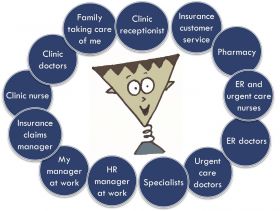We hear it all the time from hospitals and clinics: “We offer a patient-centered experience.” But, how true is that statement in reality? A friend of mine recently relayed a story that tells us that the patient is in the center, but her recent “patient at the center” experience runs contrary to the intent of those claims.
A few weeks ago, my friend Sarah had a serious dizzy spell at work that forced her to call an ambulance. After a ride to the hospital and hours in the ER, doctors had no diagnosis. She was told to see her cardiologist since she had heart issues during her last pregnancy.
After a visit with the cardiologist the next day, she checked out fine. Then Sarah scheduled an appointment with her internist, who diagnosed her with Vertigo. She was given a prescription to minimize the spinning and told it would be four to six weeks before she felt 100 percent better.
A few days later the spinning was getting worse – and it was the weekend. As a good consumer of health care, she went to the urgent care, not the ER. The doctor put her on a steroid to minimize inflammation, which helped a bit the next few days. Another referral suggestion: an Ear, Nose and Throat specialist to learn more about Vertigo. The ENT doc reassured her that the Vertigo would go away in a few weeks and answered all her questions. Overall, pretty good clinical care.
During the two weeks this all occurred, Sarah was using paid time off from work. Now, as the two-week point approached, she needed to file for short-term disability.
From fragmented to complicated.
The insurance company asked for documentation from the internist who initially diagnosed her. But the doctor was out on vacation and a nurse told Sarah she should see her primary physician and get the documentation from her.
She then called the primary physician’s clinic to see if she could rustle up the documentation. No luck. They said she had to come in for a visit before they could provide the documentation to the insurance agency. After all the previous appointments this seemed like a waste. (Is your total cost of care calculator catching all of this?)
Not surprisingly, Sarah was frustrated, having to deal with a network of clinics that didn’t talk to each other, a health plan making demands and an employer that wanted her back to work.
In Sarah’s story (thank you, Sarah) I see two morals that healthcare entities should bear in mind to drive performance.
1. The only person who has an integrated experience when it comes to healthcare is the patient.
Good clinical care isn’t enough to create a patient experience to solve her need to get back to life as usual.
Patients see all the players in the healthcare system. Yet, they experience health care for the sum of its parts—care, coordination, insurance. The tangible clinical care and process steps and the intangible elements such as responsiveness, passed-aroundness, flexibility – it’s all part of a single experience to them. At the end of the day, what integrated, holistic, single experience do you want your patients to have? Do all your decisions leverage your organization’s part of the whole or circle back solely to your segment of the patient experience?
2. With patients becoming more accountable for their healthcare, today’s system is creating tomorrow’s financial performance.
Although Sarah received great care from her internist, it won’t be all she thinks about the next time she has a problem. Why? Because of the frustration she experienced coordinating her care, I’m guessing that might make her think twice about going back. The clinic didn’t enable her to be a smarter, more effective consumer – that work was all hers to do. I believe this will directly impact the long-term performance of the clinic.
This singular view of a consumer’s experience will influence the consumer’s “purchase decisions” of one doctor over another, one health plan over another or one pharmacy over another down the road. And that impacts your performance down the road.
What about tomorrow’s patient experience?
I know that there are some very hardworking people trying to create the ideal, integrated patient-at-the-center experience. I’ve met many of them through our work at Aveus. We’re not there – yet.
What do you think Sarah’s next patient experience will look like? If you’re a leader of a healthcare organization, what can you do today to change Sarah’s patient experience tomorrow?
